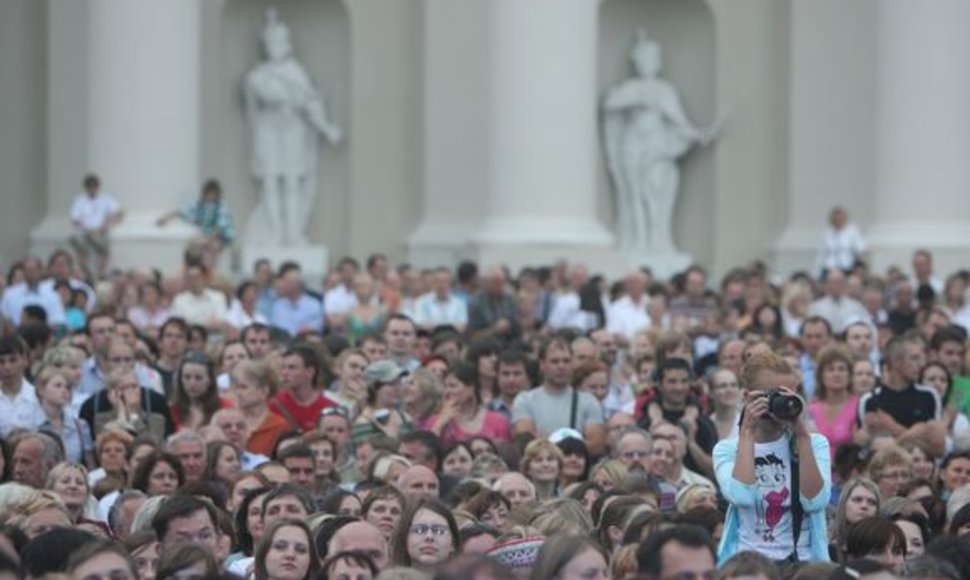Compared to 2001, the population increased only in four municipalities, including Klaipėda District, the town of Neringa, both western Lithuania, as well as Vilnius and Kaunas Districts.
The remaining 56 municipalities saw decreases in their population.
The previous census in 2001 put Lithuania's population at 3.48 million. A decade earlier, in 1989, it was 3.67 million.
Ethnicity
Ethnic Lithuanians make up 84.2 percent of Lithuania's population, census figures shows. Meanwhile the populations of two largest ethnic minorities – Polish and Russian – have dropped slightly.
154 ethnicities were recorded during the population census in March 2011. The biggest ethnic groups were Lithuanians, 84.2 percent, Poles accounted for 6.6 percent, Russians – 5.8 percent, Belarusians – 1.2 percent of the total population. In 2001, there were 83.4 percent of Lithuanians, followed by Poles (6.7 percent), Russians (6.3 percent), and Belarusians (1.2 percent).
For the first time in the history of population censuses in Lithuania, residents were allowed to give two mother tongues. 99.4 per cent of the population indicated that they had one mother tongue; of them, 85.4 per cent spoke Lithuanian. 0.6 per cent of the population (17,200) indicated that they had two mother tongues, usually Lithuanian and Russian, Lithuanian and Polish, Russian and Polish.
Based on the 2011 Census data, people of 108 citizenships lived in Lithuania. Lithuanian nationals made up 99.3 per cent of the total population. Most of the residents (99.8 per cent) indicated that they had one, 4,100 – two citizenships.
Religion
Over three fourths of the Lithuanian population identify themselves as Roman Catholics, census figures show.
Most of the Lithuania's population (2.35 million, or 77.3 percent) put themselves under the Roman Catholic community in 2011, down from 79 percent in 2001, the Statistics Lithuania reports.
125,200 people (4.1 percent) identified themselves as Christian Orthodox, 23,300 (0.8 percent) considered themselves Old Believers. 6.1 per cent of the population said they did not belong to any any religious community.
Education
The level of education of Lithuanian residents increased over a decade, according to Statistics Lithuania.
At the time of the census, 21.2 percent of the total population had higher education, compared to 12.6 percent in 2001.
Two thirds – 68.7 percent – of the total population had secondary or post-secondary education last year.
According to Statistics Lithuania, the number of women with higher or post-secondary education exceeded that of men: one-third of men and 42.3 per cent of women had higher or post-secondary education. Most of those having higher or post-secondary education were urban residents (81.6 and 69.8 percent respectively).
Under 3 million
Lithuania has a population of under 3 million since April, the Statistics Lithuania said on Friday after figures were recalculated based on the final results of the 2011 Population and Housing Census.
Lithuania had a total population of 2.988 million this September. Based on the census results, there were 3.043 million permanent residents in Lithuania on 1 March 2011.
"Based on the census results, there were 3.0434 people living in Lithuania. So the difference from the current statistics is 191,500 people, o 5.9 percent of the total," Vilija Lapėnienė, director general of Statistics Lithuania, said at a press conference on Friday.
"Over the eight months of this year, the population decreased by 19,300, and there were 2.9884 million people living in Lithuania in early September," she said.
The decrease in the population is mainly due to emigration. 15,100 more people emigrated from Lithuania than arrived in the country in January-August, although the number of repatriating people increased too.












